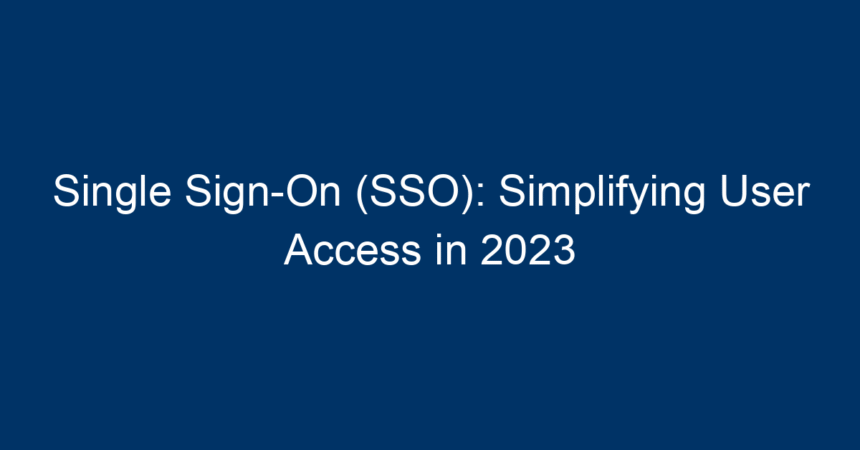In today’s digitally interconnected world, managing user credentials has become a cumbersome task. As we advance into 2023, businesses and organizations are increasingly turning to Single Sign-On (SSO) solutions to streamline user access and enhance security. But what exactly is SSO, and how can it benefit your organization? In this article, we’ll explore the ins and outs of SSO, its advantages, best practices, and actionable insights to implement it successfully.
What is Single Sign-On (SSO)?
Single Sign-On (SSO) is an authentication process that allows users to access multiple applications and services with one set of credentials. Rather than creating different usernames and passwords for each application, users can log in once and gain access to all interconnected services. This technology has gained traction as organizations look to improve user experience and reduce IT management overhead.
How Does SSO Work?
The SSO system works by establishing trust between the service provider (the applications) and the identity provider (the SSO system). Here’s a simplified breakdown of how it functions:
- User Access: A user attempts to access an application.
- Authentication Redirect: They are redirected to the SSO system for authentication.
- Credential Verification: The user inputs their credentials, which are verified by the SSO.
- Token Generation: Upon successful authentication, a token is generated and sent to the requested application.
- Access Granted: The application verifies the token and grants access to the user.
By leveraging SSO, businesses can save time and mitigate security risks associated with password management.
Advantages of Single Sign-On (SSO)
1. Enhanced User Experience
One of the most significant benefits of SSO is the improved user experience. With SSO, users no longer need to remember multiple passwords or go through lengthy login procedures. This streamlined access promotes productivity, as employees can focus on their work without worrying about password issues.
2. Improved Security
SSO enhances security measures within organizations. By reducing the number of passwords that users must manage, SSO minimizes the risk of password fatigue, which often leads to weak password practices. Moreover, many SSO solutions come equipped with multi-factor authentication (MFA) features, adding an additional layer of security.
3. Centralized User Management
IT administrators can benefit from centralized user management provided by SSO systems. With a unified platform, managing user access and permissions becomes significantly easier. Whenever an employee leaves the organization, their access can be revoked across all applications with just one action, thereby reducing security risks.
4. Cost Efficiency
Investing in SSO can be a cost-effective strategy for businesses. By streamlining access to multiple applications, organizations can reduce helpdesk calls related to password issues, saving valuable time and resources. Moreover, the consolidation of authentication systems can lead to lower compliance and audit costs as well.
5. Scalability
As businesses grow, so do their technology needs. SSO solutions are often designed to be scalable, which means they can easily integrate new applications and services as your organization expands. This flexibility makes SSO an attractive option for businesses of all sizes.
Popular SSO Protocols
Understanding the various protocols that govern SSO can help you choose the right solution for your organization. Here are some of the most commonly used protocols:
1. SAML (Security Assertion Markup Language)
SAML is widely adopted for enabling SSO in enterprise environments. It facilitates the exchange of authentication and authorization data between parties, allowing organizations to implement SSO across different platforms securely.
2. OAuth
OAuth is often used for authorization rather than authentication, but it can complement SSO. This protocol allows third-party applications to access user information without requiring users to share their passwords.
3. OpenID Connect
OpenID Connect builds on the OAuth 2.0 protocol and provides a simple way to verify users’ identities. It is widely used by tech giants like Google and Microsoft for their SSO solutions.
Implementing SSO in Your Organization: Best Practices
Assess Your Needs
Before implementing SSO, conduct a thorough assessment of your organization’s needs. Identify the applications that will benefit from SSO and establish the specific security requirements for each.
Choose the Right SSO Solution
With numerous SSO providers available, it’s crucial to choose one that fits your organization’s specific requirements. Look for features like integration capabilities, user support, and compliance with industry regulations.
Ensure Robust Security Measures
Invest in additional security measures, such as multi-factor authentication (MFA), to further enhance the security of your SSO implementation. Regularly review and update your authentication processes to keep up with evolving security threats.
Provide User Training
Educating your staff on how to use the SSO system is vital for maximizing its effectiveness. Offer training sessions and resources that help users understand how to leverage SSO for improved efficiency.
Monitor and Evaluate Performance
After implementing SSO, continually monitor its performance and user feedback. Make necessary adjustments and updates to ensure that the system is functioning at its best.
Challenges Faced with SSO
While SSO offers numerous benefits, it’s important to be aware of potential challenges:
1. Single Point of Failure
If the SSO system experiences downtime or is compromised, it could prevent access to all connected applications. Implementing redundancy and regular backups can help mitigate this risk.
2. Over-Reliance on SSO Providers
Depending on a third-party SSO provider means entrusting them with sensitive information. Always evaluate providers for security history and reliability.
3. User Resistance
Some users may be hesitant to adopt new technology. Address their concerns and provide assurance regarding the system’s security and ease of use.
Conclusion: The Future of User Access Management
As we move further into 2023, the importance of Single Sign-On (SSO) cannot be overstated. By simplifying user access and enhancing security, SSO solutions empower organizations to thrive in an increasingly complex digital landscape.
Businesses should take actionable steps to implement SSO effectively: assess needs, choose the right solution, and continuously monitor performance. Embracing SSO isn’t just about keeping up with technology; it’s about creating a seamless experience for users that fosters both productivity and security.
Whether you’re a small business or a large enterprise, investing in SSO can provide significant rewards. As digital landscapes evolve, being proactive about security and user experience will set your organization apart. Embrace the future of access management, and watch your organization thrive!




